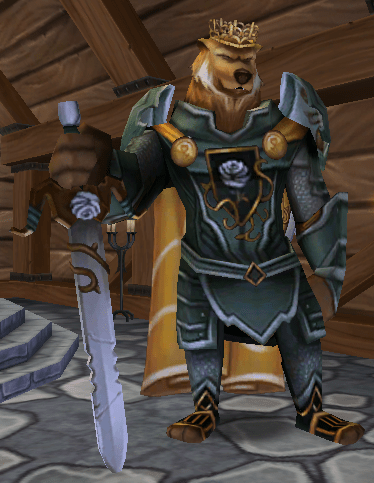King Artorius / Pendragon – King Arthur Pendragon
https://www.wizard101central.com/wiki/NPC:King_Artorius
https://www.wizard101central.com/wiki/Creature:Pendragon
https://en.wikipedia.org/wiki/King_Arthur
King Artorius is the noble and legendary King of Avalon. Merle Ambrose guided Artorius to his role as King of Avalon, and the two of them founded the Knightly Order of The Silver Rose.
King Artorius was betrayed by Morganthe’s brother Sir Mallory and weakened in battle. Morganthe was able to trick Artorius into donning the Horned Crown and he was transformed into the vile Pendragon.
So this is the little Wizard that has been running through my realm, causing havoc? You have the stink of Merle Ambrose upon you. What is that you have? The Sword of Kings? I did not think it possible for it to be raised again. Let us test your mettle against my razor fangs!
Pendragon

King Arthur (Welsh: Brenin Arthur, Cornish: Arthur Gernow, Breton: Roue Arzhur) is a legendary king of Britain, and a central figure in the medieval literary tradition known as the Matter of Britain. In Welsh sources, Arthur is portrayed as a leader of the post-Roman Britons in battles against Anglo-Saxon invaders of Britain in the late 5th and early 6th centuries. He first appears in two early medieval historical sources, the Annales Cambriae and the Historia Brittonum, but these date to 300 years after he is supposed to have lived, and most historians who study the period do not consider him a historical figure. His name also occurs in early Welsh poetic sources such as Y Gododdin. The character developed through Welsh mythology, appearing either as a great warrior defending Britain from human and supernatural enemies or as a magical figure of folklore, sometimes associated with the Welsh otherworld Annwn.
The legendary Arthur developed as a figure of international interest largely through the popularity of Geoffrey of Monmouth’s fanciful and imaginative 12th-century Historia Regum Britanniae (History of the Kings of Britain). Geoffrey depicted Arthur as a king of Britain who defeated the Saxons and established a vast empire. Many elements and incidents that are now an integral part of the Arthurian story appear in Geoffrey’s Historia, including Arthur’s father Uther Pendragon, the magician Merlin, Arthur’s wife Guinevere, the sword Excalibur, Arthur’s conception at Tintagel, his final battle against Mordred at Camlann, and final rest in Avalon. The 12th-century French writer Chrétien de Troyes, who added Lancelot and the Holy Grail to the story, began the genre of Arthurian romance that became a significant strand of medieval literature. In these French stories, the narrative focus often shifts from King Arthur himself to other characters, such as various Knights of the Round Table. The themes, events and characters of the Arthurian legend vary widely from text to text, and there is no one canonical version. Arthurian literature thrived during the Middle Ages but waned in the centuries that followed, until it experienced a major resurgence in the 19th century. In the 21st century, the legend continues to have prominence, not only in literature but also in adaptations for theatre, film, television, comics and other media.
The historical basis for King Arthur has been long debated by scholars. One school of thought, citing entries in the Historia Brittonum (History of the Britons) and Annales Cambriae (Welsh Annals), saw Arthur as a genuine historical figure, a Romano-British leader who fought against the invading Anglo-Saxons some time in the late 5th to early 6th century.
The origin of the Welsh name “Arthur” remains a matter of debate. The most widely accepted etymology derives it from the Roman nomen gentile (family name) Artorius.
An alternative theory, which has gained only limited acceptance among professional scholars, derives the name Arthur from Arcturus, the brightest star in the constellation Boötes, near Ursa Major or the Great Bear. Classical Latin Arcturus would also have become Art(h)ur when borrowed into Welsh, and its brightness and position in the sky led people to regard it as the “guardian of the bear” (which is the meaning of the name in Ancient Greek) and the “leader” of the other stars in Boötes.
Both of these theories are reflected in King Artorius’ name and design.
The current list of all the (known) Avalon references are located here.
Although I am well versed in Pop Culture references, I do not claim to have caught them all. Let me know your favorites in the comments and if I’ve missed one you caught, let me know so I can add it to the list.
Text for this article is excerpted from the linked wiki pages
King Artorius and Pendragon images are from Wizard101, and are copyright of KingsIsle Entertainment.
King Arthur as one of the Nine Worthies, detail from the “Christian Heroes Tapestry” in The Cloisters, New York image is borrowed from Wikipedia and is in the public domain.
Image usage qualifies as fair use under US copyright law.

